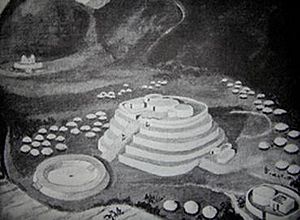La Galgada (archaeological site) facts for kids
La Galgada is an ancient ceremonial site in Peru. It's a special place where people built monuments for religious ceremonies long, long ago. This happened during a time called the Pre-Ceramic period, which was before people made pottery.
The site is located in the mountains of Peru, by the Tablachaca River. It's about 1,100 meters (around 3,600 feet) above sea level. When archaeologists found the site, they named it "La Galgada" after a nearby town. However, local people called it "San Pedro." The Pre-Ceramic period was a time of big changes in the Andes. People started to settle down more and build large, important buildings.
Contents
A Look Back in Time
The Pre-Ceramic Period in the Andes
After a very early time called the Lithic Period, came the Pre-Ceramic Period. It's also known as the Late Archaic Period. During this time, societies in the Andes became more complex. More people lived there, and they started building huge ceremonial centers.
These large buildings are a clear sign to archaeologists that people were organized enough to manage big construction projects. The population grew, and some people might have traveled to these special centers for important events. The climate also changed as the last Ice Age ended, and sea levels became stable.
Even with these changes, some things stayed the same. As the name "Pre-Ceramic" suggests, people didn't have pottery yet. They couldn't use pots for cooking or storing food. Also, they didn't farm much. They mostly hunted animals and gathered wild plants for food, just like their ancestors. But there is some evidence that they started to grow a few wild plants on purpose.
Where La Galgada Was Located
People first lived around La Galgada about 5,000 years ago, around 3000 BCE. These early communities built small, special rooms for ceremonies, separate from their homes. They put more effort into building these ceremonial and burial places than their own houses. This was common in many ancient societies.
Archaeological studies show that during the Pre-Ceramic Period, at least 11 settlements grew up along the Tablachaca Canyon. They were on both sides of the river, close to the modern village of La Galgada. One archaeologist, Terence Grieder, said that La Galgada was "one of the most important ceremonial and burial areas" in a busy region. He even called it "virtually a metropolitan center" for its time.
Ancient Buildings
At the La Galgada ceremonial site, the most important buildings were two large structures called the North Mound and the South Mound. These were central to the site's activities.
Burial Practices
La Galgada was also a place where people buried their dead. Archaeologists found that burial practices changed over time, especially how bodies were positioned and prepared. However, the types of textiles (fabrics) and offerings placed with the bodies stayed quite similar.
A Special Burial Chamber
In one burial chamber, called F-12:B-2 by the archaeologists, they found three people buried together. There was a man and two women, all over 50 years old. Each person was buried in a tightly curled position, with their arms crossed on their chest and lying on their left side.
Their bodies had been wrapped tightly with cotton cords. The man's cord was dark brown and spun in a special way, which might mean it was very important. The women's cords were yellow and tied around them many times.
Archaeologists also found tufts of human hair tucked around the bodies, especially near the torso and hips. It's possible this hair belonged to the people buried there, as they didn't have hair on their heads. Instead, they wore hats that looked like they were made from old bags or baskets. Some ancient Andean people believed that a person's soul was especially present in their hair. So, archaeologists think stuffing hair into the clothing might have been a way to keep the "spiritually important hair" close to the body.
Another interesting item found with two of the bodies was barkcloth. This is a useful material made from the bark of certain trees. The man's body was mostly covered in dark brown strips of barkcloth. One of the women also had similar strips. Archaeologists believe that people included barkcloth because they thought it had "spiritual power." This was a common belief in many ancient American cultures.
Archaeologists at Work
By the 1960s, La Galgada had become a busy mining town. The ancient site was in danger from people who wanted to dig up valuable artifacts to sell. However, the town's governor, Teodoro E. López Trelles, understood how important the site was for history. He took steps to protect it.
In 1969, he showed the site to Terence Grieder, an archaeologist from the University of Texas at Austin. Grieder was working on another site nearby, but he was so interested in La Galgada that he decided to investigate it later.
In 1976, Grieder and another archaeologist, Alberto Bueno Mendoza, returned to La Galgada. They realized the site was from the Pre-Ceramic period, which meant it was much older than they first thought! They started raising money for an excavation, which began in 1978 and continued until 1985.
See also
 In Spanish: La Galgada para niños
In Spanish: La Galgada para niños


